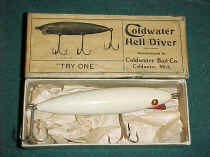Eureka Wiggler, Coldwater, Mich.The Eureka Wiggler first appeared around 1913. These fat baits are believed to be the first of a succession of similar lures. They featured wonderful, long hand-painted gills and came in some wild colors, including orange crackleback as seen here. The box picture shows a frog spotted Eureka Wiggler with tail washer. |
 |
Eureka Wiggler, Coldwater, Mich.The Eureka Wiggler was patented in 1914. These fat baits are believed to be the first of a succession of similar lures. They featured wonderful, long hand-painted gills and came in some wild colors, including red crackleback. Red and white is the most common color. |
 |
|
This very unusual Eureka Wiggler box is hand-colored to match the green crackleback lure inside. Boxes like the one above are typical; this example is a one-of-a-kind as far as I know, and it resided in the well-known Donelly Collection in northern Michigan for almost a decade before a complex, three-way trade landed it here. |
 |
Coldwater Wiggler The Coldwater Wiggler box carried the June 9, 1914 patent date, as well as a picture of this appealing classic antique lure. It's slogan "the live one" also appears on the box for the Eureka King, further linking these two companies. The company also made the Coldwater Finch Surface Bait whose wood body resembles the Wiggler |
 |
Coldwater Hell Diver The Coldwater Helldiver was a diving bait. This one is unusual in that it has glass eyes. The picture box features the patent date of May 14, 1918. This lure is later than the Phinney's Helldiver example pictured below. Shakespeare eventually bought and manufactured this lure. Glass-eyed Coldwater Hell Diver lures are rare. |
 |
|
Phinney's Helldiver W.E. Phinney was a contemporary and apparent on-again, off-again partner of Sam Larrabee. This is the first and earliest Phinney's Helldiver, with no eyes, hand-painted gills and packaged in the Phinney's Helldiver "patent applied for" box. The color flyer inside mentions rods, reels and other tackle. Shakespeare later sold the Helldiver. |
 |
The Coldwater Skipper is somewhat of a mystery. It has the body of a Coldwater Wiggler, with one exit hole, and the added feature of a front propeller. This is a one-of-a-kind piece as far as I know, and was found in Michigan by well-known collector Riley Smith, who very graciously allowed it to be traded into this collection. The labeled box is identical in size to the Phinney Helldiver box shown above, and likely has Phinney's label underneath. |
 |
Here's another view of the Coldwater Skipper, which features the elegant frogspot pattern that makes some Coldwater/Eureka lures irresistable to collectors. The large chin hole is painted red inside and the belly hooks are fastened with strong nickel-plated cups. The Skipper has no tail washer as most standard Wiggler's do. This piece likely dates to 1915-17. Like the Coldwater Finch Surface Bait, it has a propeller at the front. |
 |
Coldwater GhostThe Coldwater Ghost was first thought to be only a luminous bait. Others have speculated the lures had a different configuration of exit holes. I sort of think it's merely the white version of the Coldwater Wiggler. Nonetheless, the box, dated 1914, recommends to "expose to light before using." The red in the holes is beautifully blended. |
 |
|
Here is another Coldwater Ghost in a different, perhaps earlier "black box" that has the "expose to light or electric" suggestion across the top in large lettering. The lure inside is luminous with red inside the hole. This box also has the 1914 patent date. I consider this to be the rarest of the Coldwater Ghost boxes, and also the most appealing. Note the 2-hook lure matches the box picture. |
|
Coldwater KingBoth Coldwater and Eureka made the classic "Coldwater King" bait with four or five separate line ties. The Coldwater version to the right has a rectangular lip with four line ties, and matches the picture on the box, which is dated Sept. 11, 1917. The green back blends to a white belly. It also came in luminous finish. |
 |
Coldwater King, No. 73, WhiteThis Coldwater King lure is flawless and mint - and in its correctly marked box for the color. Inside the box, the original paper wrapper remains intact. This lure is occasionally found in a glass-eyed version, but the vast majority of them have no eyes. |
|
Eureka KingHere is the Eureka King - another version of the Coldwater King. Notice the pointed, triangular front lip with five line ties, and how it matches the picture on the box, which also carries the 1917 date. Many people can't tell the difference between Coldwater King and Eureka King lures. I hope this lessens the mystery. Note the frog spot finish. |
 |